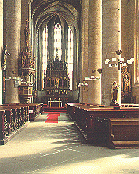 St. Bartholomew's Church
St. Bartholomew's Church St. Bartholomew's Church
St. Bartholomew's Church Link to the St. Bartholomew's Church video clip.
Link to the St. Bartholomew's Church video clip.
St. Bartholomew's Church is an outstanding building dating from the late 13th to early 16th century.
It combines three developmental Gothic features on the principle of a three-part nave entrance hall. It is the dominant architectural feature of the city. Building of the cathedral commenced at the end of the 13th century with the presbytery, now no longer standing.In 1322 when the Order of German Knights definitively gained a parish, the perimeter walls of the imposing three-part nave were built, including the run-outs of an intended cross-vaulted ceiling which, in fact, was never constructed.
In the 1330s, both towers of the western facade were built up to the same height and between them the valuable portal. Thus arose the notable post-Classical Gothic hall, a high room with three naves of the same height. On account of the monumental naves the presbytery under construction was demolished and a new, elevated one built, this in the reign of Charles IV. The tall, narrow windows with complex traceries basically replace the wall between the pillars of the apse. At this time only the northern tower was completed. This age renounced strict symmetry. The side portals date from 1400 in the spirit of Czech national post-Parler Gothic. The three-part nave of the time, only temporarily roofed over, was arched in the era of Jiri of Podebrady around 1480. The complex and picturesque late Gothic star vaults rest on three pairs of tall cylindrical pillars. At the same time the sacristy appeared and, above it, the treasury.
After a fire in 1507, the church was repaired 1510-1529 and alongside the southern hall, the richly decorated Sternberk burial chapel in late Gothic style was added. In the Renaissance period the gables of the ridge roof were renewed, receiving Venetian curves. The roof dormers were similarly decorated.
Then in 1663, a beautifully carved late Renaissance door was fitted to the west portal. In 1634 a wooden crucifix was erected on the inner pillar of the presbytery, this being the first appearance of Baroque in Plzen. The peak of Baroque (1713) added an iron lattice to the adjacent late Gothic Oliveta from 1468.

Striking changes in the appearance of the church date from the 19th century. In 1803 a French Imperial clock was installed on the spire, in 1835 the spire was struck by lightning during a storm at night and was burnt. It assumed its present form in 1837, more slender and higher than before (at 331 ft 6 in the highest in Czechoslovakia).
1879 - 1883 the church, distinctly shabby, was restored in Purist style to the design of Josef Mocker, who re-Gothicized the gables and dormers and built a pseudo-Gothic hall onto the north portal. He also appreciably re-Gothicized the interior, removing the Baroque altars which had still remained after Joseph's intervention.In the 20th century the Sternberk Chapel was restored almost from ruins under the supervision of Kamil Hilbert and was opened to the public in 1923. The interior of the church was greatly impoverished by Joseph's practicalism, 26 altars being removed and only 7 remaining. The main Baroque altar was replaced by a pseudo-Gothic one, the work of J.Mocker which he designed himself. At the centre of the altar he left the famous Plzen Madonna, a work of European significance as one of the most notable statues belonging to the well-known Czech type of splendid Madonnas. It is a claystone statue about 4 ft 6 in high from around 1390. Either side of it on the altar there are wooden statues of saints from the abandoned altars of the 16th and 17th century. The pillars of the three-part nave carry statues of Calvary, which were originally high on the beams of the triumphal arch. They are statues of the Virgin Mary and St.John, compact in form, and a crucifix - the work of a Plzen master from the 1470s, one of the greatest artists of the time in Bohemia. The pulpit, with its rich chiselled circlings, dates from the same period.
The Madonna, known as the Madonna of Plzen
From the reign of Rudolph II there is a copy of Domenico Tintoreto's "Mary Magdalene" hanging on the pillar of the south nave oft he church. On the north side of the nave, near the altar, there is the architectural epitaph of the Plzen burgess Matyas Bakalar of Sonnenburk (d. 1612), designed in the spirit of Dutch-German Renaissance. The pews in the nave are from 1699. The two confession boxes and Calvary in the presbytery are the work of Lazar Widman dating from 1765.
The early Baroque altars at the front of the side naves date from the period after the Thirty Years' War and the altars by the walls of the naves from around 1660. The two pseudo-Gothic altars are decorated with pictures of St.Wenceslas and St.Prokop by Frantisek Sequens (1836-1896), a native of Plzen.The Sternberk Chapel is decorated with Renaissance wall paintings, by the wall on the plinth there is the pewter coffin of Bohunka of Lobkovice (d. 1609), exhumed from the ground. After restoration, the Czech altar was installed into the chapel. The altar is the work of Professor Jan Kastner from the late 19th century. The gallery of the tower, at a height of 195 ft, provides a fine view of the city.
 and
Czech
and
Czech  versions.
versions.
Copyright © 2002 City of Plzen. All Rights Reserved.